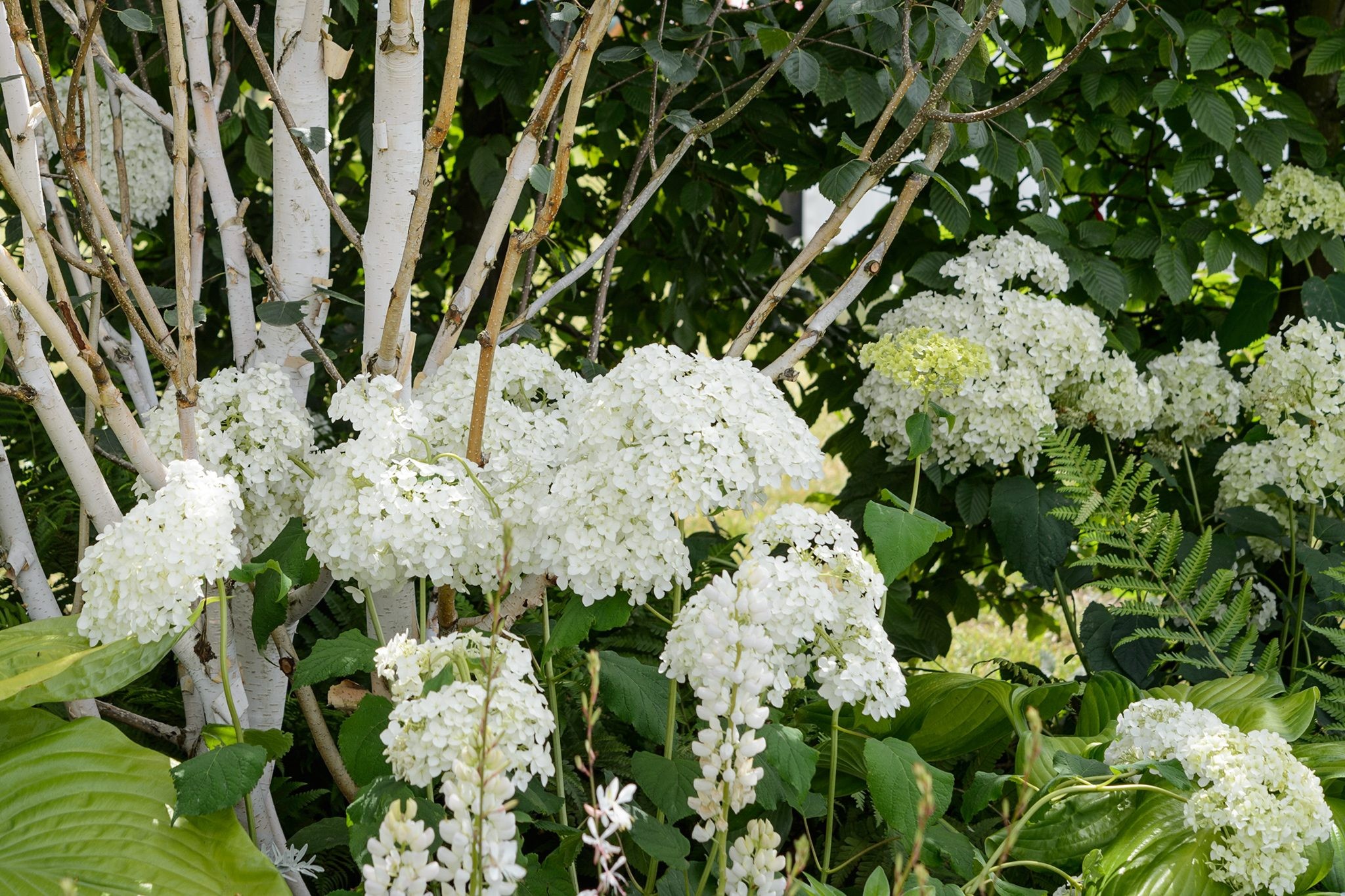Hydrangeas are beloved for their stunning blooms and lush foliage, adding a touch of elegance to any garden. Whether you’re a seasoned gardener or just starting out, understanding how to properly care for hydrangeas is key to enjoying their vibrant beauty year after year. This guide provides expert advice on everything from planting and watering to pruning and troubleshooting common issues, ensuring your hydrangeas thrive in your garden.
Where to Plant Hydrangeas
Choosing the right location is crucial for healthy hydrangea growth. These plants flourish in moist, well-draining soil and prefer dappled shade. Ideal spots are those that are not too sunny and not too shady. It’s best to avoid south-facing locations, especially if your soil tends to be dry, as intense afternoon sun can scorch the leaves and dry out the soil too quickly. For north-facing walls or very shaded vertical spaces, consider climbing hydrangeas like Hydrangea anomala subsp. petiolaris, which are well-suited to these conditions.
Hydrangeas, particularly young growth, are vulnerable to frost damage in the spring. Therefore, select a planting site that is not in a frost pocket and is sheltered from strong winds. Protecting them from harsh weather conditions will help ensure robust growth and abundant flowering.
Most soil types are suitable for hydrangeas, including both alkaline and acidic soils. However, it’s important to note that soil pH can influence the flower color of certain hydrangea varieties, particularly Hydrangea macrophylla and Hydrangea serrata. Pink varieties may turn blue in acidic soil due to the increased availability of aluminum.
When to Plant Hydrangeas
The optimal times to plant hydrangeas are spring or autumn. During these seasons, the soil is typically warm and moist, providing ideal conditions for root establishment. Planting in spring allows the hydrangeas to establish roots before the heat of summer, while autumn planting gives them a head start before winter dormancy.
While summer planting is possible, it requires more diligent watering. You’ll need to water frequently to prevent the plant from drying out before its root system is well-established. Extra care during the initial stages of summer planting ensures the hydrangea adapts successfully to its new environment.
How to Plant Hydrangeas
Hydrangeas thrive in soil that retains moisture. If your soil is light and sandy, amend it with moisture-retaining organic matter before planting. Well-rotted manure or compost are excellent choices to improve soil structure and water retention.
Before planting, thoroughly water the hydrangea while it’s still in its container about an hour beforehand. This ensures the root ball is moist and easier to handle. When planting, ensure that the top of the root ball is level with the soil surface; never plant a hydrangea deeper than it was in its original pot. After planting, water generously to settle the soil around the roots.
Mulching is beneficial after planting. Apply a layer of leaf mold, well-rotted manure, or compost around the base of the hydrangea. Mulch helps to retain soil moisture, suppress weeds, and regulate soil temperature. During the first spring and summer after planting, consistent watering is crucial to support healthy root development and overall plant establishment.
For climbing hydrangeas, initial training onto galvanized wires is recommended. This provides support as they begin to grow. After a season, they will naturally cling to surfaces using their aerial roots, becoming self-supporting climbers.
Hydrangea Care Tips
-
Watering: Regular watering is essential, particularly during the first growing season. Aim for weekly watering, or more frequently if needed, to help the roots establish deeply. Rainwater is preferable for watering hydrangeas, especially if you want to maintain blue flower color in varieties susceptible to color change.
-
Watering in Hot Weather: Hydrangeas are sensitive to dry conditions and can wilt in hot weather. Be prepared to provide extra water during summer heat spells, especially for plants in full sun. Wilting is a clear sign that your hydrangea needs immediate watering.
-
Mulching: Apply a fresh layer of mulch every spring. Leaf mold, well-rotted manure, or compost are all excellent mulching materials. Mulching conserves soil moisture, reduces weed competition, and enriches the soil as it decomposes.
-
Fertilizing: In general, avoid excessive fertilization as it can promote leafy growth at the expense of flowers. However, for lacecap and mophead hydrangeas, and Hydrangea serrata, you can influence flower color by using a fertilizer low in phosphorus and high in potassium to encourage blue blooms.
-
Changing Flower Color: To maintain blue flower color, you can grow hydrangeas in pots using peat-free ericaceous compost and water with rainwater. Changing flowers from blue to pink is more challenging and requires raising the soil pH by adding dolomitic lime. It’s common for plants to display mixed flower colors in their first year, and many gardeners appreciate the natural color variations without attempting to alter them.
How to Prune Hydrangeas
Proper pruning is essential for maintaining hydrangea shape, encouraging flowering, and removing dead or congested growth. Pruning techniques vary depending on the hydrangea type, as different groups bloom on old wood (growth from the previous season) or new wood (current season’s growth).
Hydrangea macrophylla (lacecap and mophead hydrangeas) and Hydrangea serrata: Prune these types in mid-spring. They bloom on old wood, so avoid heavy pruning as it will reduce or eliminate summer flowers. Traditionally, old flowerheads are left over winter to protect new growth from cold. In spring, cut back the old flowerheads just above the first set of plump buds beneath the dead flowerhead – these buds will produce the new flowers. For overgrown plants, remove some older stems at the base to thin out congestion.
Hydrangea paniculata and Hydrangea arborescens: Prune these in early spring. Pruning is not strictly necessary, but without it, plants can become very tall with flowers mostly at the top. These types flower on new wood, allowing for harder pruning without sacrificing blooms. Cut back last year’s growth to a healthy framework, leaving about 30-60cm (1-2 feet) in height, depending on desired plant size. Prune each stem just above a pair of healthy buds.
Hydrangea aspera and Hydrangea quercifolia: Prune lightly in spring. Only remove dead, crossing stems, and old flowerheads. Minimal pruning is needed for these varieties.
Hydrangea petiolaris (climbing hydrangea): Prune in summer, immediately after flowering. Cut back the flowered shoots to a pair of new buds. Summer pruning encourages better flowering in the following year and helps maintain shape.
How to Propagate Hydrangeas from Cuttings
Propagating hydrangeas from cuttings is a straightforward way to create new plants. Softwood cuttings, taken in spring, are most successful.
- Take Cuttings: In the morning, select young, non-flowering shoots with three sets of leaves. Prepare your cutting material promptly for best results.
- Prepare Cuttings: Remove the lower two sets of leaves and shorten the stem just below a node (the point where leaves emerge). Reduce the surface area of the remaining leaves by cutting them in half to minimize water loss.
- Plant Cuttings: Insert cuttings into a pot filled with gritty compost or multi-purpose compost mixed with perlite for improved drainage. You can place multiple cuttings in one pot, ensuring leaves don’t touch.
- Water and Cover: Water the cuttings thoroughly and cover the pot with a clear plastic bag to create a humid environment, like a mini-greenhouse. Ideally, place them in an unheated greenhouse or a sheltered, shady spot.
- Potting On: Once you observe clear signs of new growth, indicating successful rooting, carefully pot the new plants individually. Continue to keep them in a shady location as they establish.
Growing Hydrangeas: Problem Solving
Hydrangeas are generally easy to grow and relatively problem-free. However, some common issues can arise.
Lack of Flowers: The most frequent cause is incorrect pruning. Ensure you are pruning at the right time of year for your specific type of hydrangea (old wood vs. new wood bloomers). Review the pruning guidelines above to ensure you’re using the correct method.
Climbing Hydrangea Not Flowering: Climbing hydrangeas may take a few years to establish and begin flowering. Ensure they are planted in a suitable location and are receiving adequate sunlight (morning sun, afternoon shade). Lack of sunlight or over-fertilization can inhibit flowering.
Frost Damage: Brown or blackened foliage or buds in spring typically indicate frost damage. Plant hydrangeas in sheltered locations, away from frost pockets. Leave faded flowerheads on over winter to provide some insulation to new buds. If frost damage occurs, allow the plant to recover as weather warms, and prune only dead or damaged areas in late spring.
Purple Leaves: Purple leaves can result from a sudden temperature drop, particularly in spring or autumn. In spring, leaves usually revert to green as temperatures rise. In autumn, purple leaves may be a natural color change as the plant prepares for dormancy. However, persistent purple leaves can also signal phosphorus deficiency, especially in plants where flower color has been altered. Soil testing and appropriate fertilization with a phosphorus-rich fertilizer may help.
Hydrangea Scale: Hydrangea scale is a sap-sucking insect. Severe infestations can cause weak growth and leaf loss. Look for white, waxy egg masses in early summer and brown, blob-like mature scale insects. For serious infestations, treat in July with an organic insecticide based on plant oils or fatty acids.
Vine Weevils: Vine weevils can affect potted hydrangeas. Notched leaf edges are a visible sign, but the primary damage is done by C-shaped white grubs in the soil that eat the roots. This can lead to rapid plant decline. Use appropriate vine weevil control methods, such as nematodes or chemical controls, particularly for container plants.
Advice for Buying Hydrangeas
When purchasing hydrangeas, consider these factors to ensure success:
- Local Suitability: Check if hydrangeas thrive in your local area. Observe neighboring gardens to get an idea of soil types and hydrangea suitability in your region.
- Flower Color Change: Be aware that the flower color of some hydrangeas may change based on your garden soil pH. If you want to maintain blue flowers, consider planting in pots with ericaceous compost.
- Mature Size and Requirements: Check the expected mature height and spread of the hydrangea variety, as well as its specific growing requirements. Ensure you have the right conditions in your garden for the chosen variety to flourish.
Nine of the Best Hydrangeas to Grow
-
Hydrangea macrophylla ‘Ayesha’: Mophead with unique, curled florets in silvery lavender flowerheads. Matures to 1.5m x 1.5m.
-
Hydrangea macrophylla ‘Zebra’: Dramatic white mophead flowers, near-black stems, and rich-green leaves. Reaches 1m x 1m.
-
Hydrangea macrophylla Miss Saori: RHS Chelsea Plant of the Year 2014 with double pink and white flowers, offering two flushes of bloom. Grows to 1m x 1m.
-
Hydrangea macrophylla ‘Veitchii’: Hardy lacecap with large, white bracts turning pink, surrounding small flowers that fade from blue to violet. Size: 1.6m x 1.6m.
-
Hydrangea macrophylla ‘Jogasaki’: Lacecap with bracts ranging from pale pink to icy blue, vibrant autumn leaf color. Size: 1.5m x 2m.
-
Hydrangea serrata ‘Bluebird’: Lacecap with pink or blue florets around tiny blue flowers, fiery autumn foliage. Size: 1.2m x 1.2m.
-
Hydrangea paniculata ‘Phantom’: Conical flowerheads starting white/green, turning pink/red, yellow-tinged tips. Size: 1.8m x 2m.
-
Hydrangea arborescens ‘Annabelle’: Domed white/pink flowerheads fading to lime-green. Size: 2.5m x 2.5m (smaller with pruning).
-
Hydrangea quercifolia: Oak-shaped leaves turning fiery autumn shades, conical flowerheads. Size: 2m x 2.5m.
-
Hydrangea paniculata ‘Limelight’: Upright shrub with yellow-green leaves, green flowers fading to creamy white then pink. Size: 2.5m x 2.5m.
Frequently Asked Questions About Hydrangea Care
Can I grow hydrangeas in shade?
Hydrangeas thrive in partial shade or dappled sunlight. In hotter climates, they can tolerate full shade in the afternoon if they get morning sun. Too much shade, however, can reduce flowering and lead to weak, floppy stems. Aim for a location that provides a balance of light and shade for optimal growth and flowering.
When is the best time to move a hydrangea?
The best time to transplant a hydrangea is during its dormant period, from mid-autumn to late winter. Moving hydrangeas while they are dormant minimizes stress and allows them to establish roots in their new location before the active growing season begins.
What compost should I use for a hydrangea in a pot?
Hydrangeas are well-suited to container growing. Use a soil-based compost like John Innes No.3, potentially mixed with some multi-purpose compost to enhance drainage and aeration. Ensure your pot has drainage holes at the bottom to prevent waterlogging, which can be detrimental to hydrangea health.


